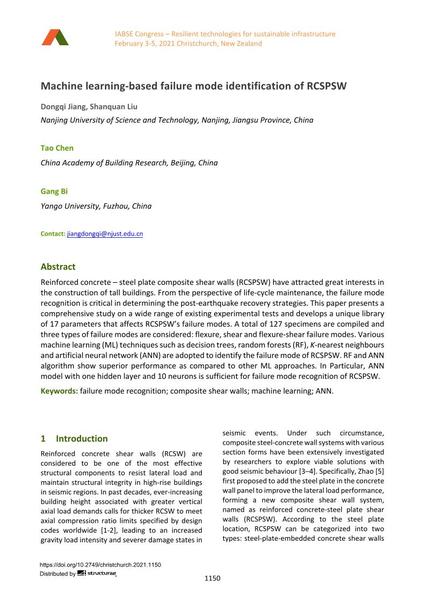Machine learning-based failure mode identification of RCSPSW

|
|
|||||||||||
Bibliografische Angaben
| Autor(en): |
Dongqi Jiang
(Nanjing University of Science and Technology, Nanjing, Jiangsu Province, China)
Shanquan Liu (Nanjing University of Science and Technology, Nanjing, Jiangsu Province, China) Tao Chen (China Academy of Building Research, Beijing, China) Gang Bi (Yango University, Fuzhou, China) |
||||
|---|---|---|---|---|---|
| Medium: | Tagungsbeitrag | ||||
| Sprache(n): | Englisch | ||||
| Tagung: | IABSE Congress: Resilient technologies for sustainable infrastructure, Christchurch, New Zealand, 3-5 February 2021 | ||||
| Veröffentlicht in: | IABSE Congress Christchurch 2020 | ||||
|
|||||
| Seite(n): | 1150-1157 | ||||
| Anzahl der Seiten (im PDF): | 8 | ||||
| DOI: | 10.2749/christchurch.2021.1150 | ||||
| Abstrakt: |
Reinforced concrete – steel plate composite shear walls (RCSPSW) have attracted great interests in the construction of tall buildings. From the perspective of life-cycle maintenance, the failure mode recognition is critical in determining the post-earthquake recovery strategies. This paper presents a comprehensive study on a wide range of existing experimental tests and develops a unique library of 17 parameters that affects RCSPSW’s failure modes. A total of 127 specimens are compiled and three types of failure modes are considered: flexure, shear and flexure-shear failure modes. Various machine learning (ML) techniques such as decision trees, random forests (RF),K-nearest neighbours and artificial neural network (ANN) are adopted to identify the failure mode of RCSPSW. RF and ANN algorithm show superior performance as compared to other ML approaches. In Particular, ANN model with one hidden layer and 10 neurons is sufficient for failure mode recognition of RCSPSW. |
||||
